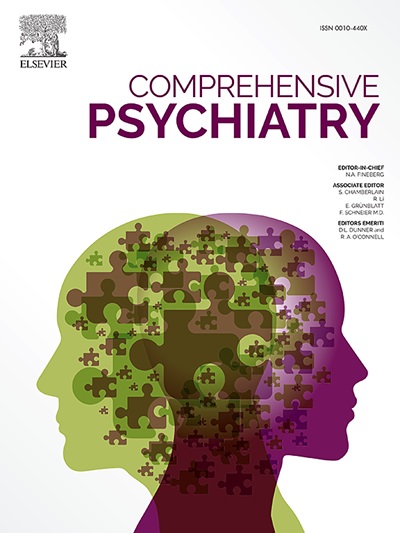通过肢体语言揭示社交焦虑的神经生理基础:一项ERP研究
IF 4.2
2区 医学
Q1 PSYCHIATRY
引用次数: 0
摘要
肢体语言在情绪感知中起着至关重要的作用,但社交焦虑个体处理这些信号的非自愿神经机制尚不清楚。本研究通过在三刺激古怪范式中分析P3a、P1和N190等视觉成分来探讨这些机制。方法采用Liebowitz社交焦虑量表(LSAS)将被试分为高社交焦虑组(HSA, n = 31)和低社交焦虑组(LSA, n = 26)。该范式采用定制设计的描绘积极、消极和中性身体表情的干扰物来检查这些刺激的非自愿加工。结果高社交焦虑(HSA)个体的P3a波幅显著高于低社交焦虑(LSA)个体,尤其是对积极的身体表达。相反,消极表达引起的振幅最弱。N190组分对积极表达的响应最强烈,对消极表达的响应最小,而P1组分在所有类型中表现出一致的响应。结论shsa个体对身体表达的加工更强烈,且对其高度敏感,无论其价态如何。这种见解可以为针对他们的认知和情感偏见的干预提供信息。本文章由计算机程序翻译,如有差异,请以英文原文为准。
Unraveling the neurophysiological underpinnings of social anxiety through body language: An ERP study
Objective
Body language plays a vital role in emotion perception, yet the involuntary neural mechanisms through which individuals with social anxiety process these signals remain unclear. This research investigates these mechanisms by analyzing visual components such as P3a, P1, and N190 within a three-stimulus oddball paradigm.
Method
Participants were classified into high social anxiety (HSA, n = 31) and low social anxiety (LSA, n = 26) groups using the Liebowitz Social Anxiety Scale (LSAS). The paradigm employed custom-designed distractors depicting positive, negative, and neutral body expressions to examine the involuntary processing of these stimuli.
Results
The findings indicate that individuals with high social anxiety (HSA) showed significantly higher P3a amplitudes than those with low social anxiety (LSA), especially for positive body expressions. In contrast, negative expressions elicited the weakest amplitudes. The N190 component responded most strongly to positive expressions and least to negative ones, while the P1 component showed uniform responses across all types.
Conclusions
HSA individuals process body expressions more intensely and are highly sensitive to them, regardless of valence. This insight can inform interventions targeting their cognitive and emotional biases.
求助全文
通过发布文献求助,成功后即可免费获取论文全文。
去求助
来源期刊

Comprehensive psychiatry
医学-精神病学
CiteScore
12.50
自引率
1.40%
发文量
64
审稿时长
29 days
期刊介绍:
"Comprehensive Psychiatry" is an open access, peer-reviewed journal dedicated to the field of psychiatry and mental health. Its primary mission is to share the latest advancements in knowledge to enhance patient care and deepen the understanding of mental illnesses. The journal is supported by a diverse team of international editors and peer reviewers, ensuring the publication of high-quality research with a strong focus on clinical relevance and the implications for psychopathology.
"Comprehensive Psychiatry" encourages authors to present their research in an accessible manner, facilitating engagement with clinicians, policymakers, and the broader public. By embracing an open access policy, the journal aims to maximize the global impact of its content, making it readily available to a wide audience and fostering scientific collaboration and public awareness beyond the traditional academic community. This approach is designed to promote a more inclusive and informed dialogue on mental health, contributing to the overall progress in the field.
 求助内容:
求助内容: 应助结果提醒方式:
应助结果提醒方式:


